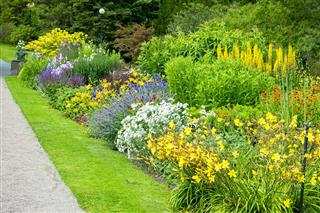
A basic tip for maintaining lovely perennial flower beds is to grow plants after understanding the height, flower color, length of bloom, flowering time and most importantly, the growing conditions. You can create a beautiful flower bed by arranging the bright-colored flowers in a unique pattern.
Perennial flower beds can be considered a basic component of a well-planned landscape design. They not only complement a garden, but are easy to maintain as well. Once a perennial garden is established, you can follow simple maintenance tips to preserve its aesthetic value. The color and flower type of perennial plants are plentiful; you can select specific varieties as per your theme. As we already know, the blooming period of perennial plants is short, usually 4 – 6 weeks. However, a properly planned perennial garden will give you the advantage of enjoying vibrant flowers throughout the year. So while designing the flower beds of a perennial garden, make sure that you plan the theme, bed design and the plant variety well.
DESIGNS FOR PERENNIAL FLOWER BEDS
Though perennial flowers can be grown randomly, plantation in beds gives a special visual impact. When viewed at a glance, vibrant flowers appear more beautiful when they bloom in groups, rather than in singles. A perennial garden bed with full bloomed flowers is appreciated by every viewer. You can practice basic landscaping ideas for flower beds while designing a perennial garden. Take a look at the images given below to see what kind of designs you can incorporate into your garden.
DESIGNING TIPS
Given below are some useful tips for designing and maintaining attractive and colorful garden beds.
Decide the Theme
First of all, select the theme for your perennial garden. You can opt for a formal tone, scented type (roses and lavender), butterfly garden (salvia and buddleia), water garden, or any other theme of your choice. If you are a beginner, it is always better to choose a manageable, yet attractive theme. Once you gain knowledge about the maintenance regarding various themes, you can go for more complex garden plans.
Plan the Width of the Beds
Lay out the plan of the flower beds according to the area of the yard. A wider bed gives more flexibility for designing. Also, too many narrow flower beds give a crowded appearance. Keep in mind that very wide garden beds are difficult to manage, as you will not be able to reach the plants in the middle. A bed that is 8 – 10 feet wide is the preferable dimension.
Select the Flowers
Selecting the plant variety is the most crucial step for designing a perennial flower garden. A simple trick is to select plants according to their required growing conditions (soil, light, water, temperature), so that they grow luxuriantly and bloom in your garden. Of course, it is important to consider the height, flower color, length of blooming and flowering time of the plants. Don’t choose a flower just because you like its color, size, or shape; rather consider its suitability, growth and maintenance level.
Create a Color Scheme
You can sort out the plants according to their size, bloom color and blooming time prior to creating a color scheme. Also, make sure you take a note of the light requirements while grouping perennial flowers. Speaking about the color scheme of flower beds, you can group plants of different colors in odd numbers. A cluster of three perennial plants with varied colors look appealing. Likewise, you can create a different design. Warm flower colors include yellow, orange and red together, while cool colors are white, pink, purple and blue.
Plantation Pattern
While growing perennial plants, place the short varieties (like dianthus and phlox) in the front row and tall plants (like peony and iris) at the back. You can include 14 – 18 inch tall flowers in the front section, 1 – 3 feet tall varieties in the middle portion and 3 – 5 feet perennial flowers at the back. This way you can enjoy all the lovely plants despite the fact that they have different heights.
In addition to perennial flowers, you can also add other garden accessories like ornamental grasses, ferns, hostas, trailing vines, bushes and shrubs. Place the accessories in proper spots to enhance the look. For example, trailing vines can be grown to create a background, while ornamental ferns and grasses can be used for filling up spaces between two beds, or as borders to the flower beds. Last but not the least, proper maintenance is necessary to preserve eye-catching beauty of the perennial garden. So take good care of your flower garden to display its magnificence to the fullest!









